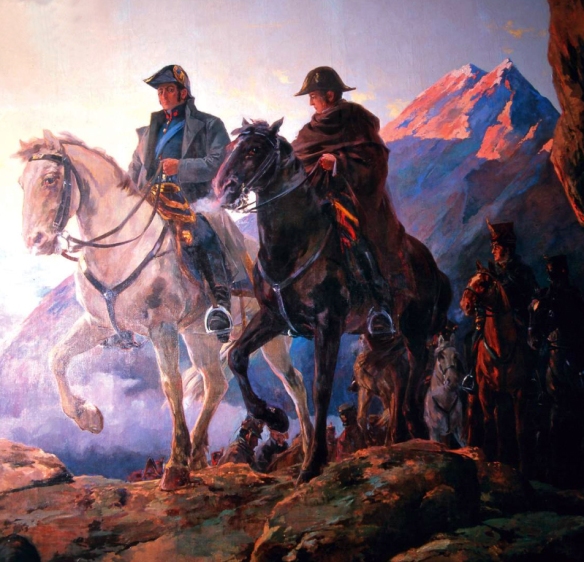Generals José de San Martín (left) and Bernardo O’Higgins (right) during the crossing of the Andes.
Battle of Maipú, painted in 1837
The “Embrace of Maipú” between José de San Martín and Bernardo O’Higgins, after the victory in the Battle of Maipú.
When news that Napoléon (1769-1821) had deposed King Ferdinand VII (1784-1833) of Spain reached Chile, the Spanish captain-general was deposed, and a junta, outwardly professing loyalty to Ferdinand, took control and engaged in ousting colonial administrators and opening Chilean ports to free trade. Chile’s revolutionary movement was torn by violent strife between the radical followers of José Miguel Carrera (1785-1821) and the moderates under Bernardo O’Higgins (1778-1842) from 1811 to 1814. This enabled the Spanish royalist army to defeat the revolutionaries at the Battle of Rancagua in 1814 and to reestablish royal control of Santiago. O’Higgins and Carrera then joined forces with José de San Martin (1778- 1850), who for three years had been organizing and training an army at Mendoza in western Argentina for the liberation of Peru by way of Chile. San Martin soon exiled Carrera because of seditious activities. In early 1817, some 5,000 soldiers, led by San Martin, crossed the Andes-a feat never done before-and defeated the Spanish at the Battle of Chacabuco on February 12, 1817. San Martin took Santiago and proclaimed Chilean independence a year later. A final defeat of royalist forces by San Martin’s army on the banks of the Maipú River on April 5, 1818, secured independence. Spain’s hold on the Chilean coast and sea lanes was broken by Chile’s small navy under the command of Lord Thomas Cochrane (1775-1860), an able British officer, who successfully bombarded Spanish forts and seized numerous warships between 1818 and 1820.
#
By 1816 the royalist cause, backed by military power, appeared in the ascendant. In Chile, the Patriot army was decisively defeated in October 1814 by royalist forces descending from Peru; in New Spain, a year later, Morelos was caught, defrocked and executed; and by the end of 1816 Morillo’s army had recovered control over most of Venezuela and New Granada. The remoteness of the La Plata region offered at least temporary protection from royalist attempts to recover it, but even here by 1816 the cause of independence was in serious trouble. The newly instituted regime in Buenos Aires proved incapable of asserting its authority over Paraguay, which had declared its own independence in 1811, or over the Banda Oriental, which was later to evolve into an independent Uruguay. One after another the military expeditions that it despatched to Upper Peru were driven back; and although a congress in Buenos Aires proclaimed the `independence of the United Provinces of South America’ in July 1816, the provinces of the Argentine interior, resolutely opposed to domination by the porteños of Buenos Aires, proved to be very far from participating in the unity. By this time, Spain was planning to send a military expedition to the River Plate, and the movement for independence threatened to unravel.
The subsequent five years, however, were to see a spectacular reversal of fortunes, brought about in large measure by the courage, skill and persistence of a handful of revolutionary leaders who were not prepared to abandon their struggle for independence. In the southern half of the continent the breakthrough for the independence movement came with José de San Martin’s creation of an army of the Andes. In 1817 his forces struck westwards from Mendoza, hazardously making their way across the mountains in a bold attempt to break the power of the royalists and their hold over Lima. With his victory at Maipú, outside Santiago, on 5 April 1818 San Martin effectively freed Chile, only to find on entering Peru that its creole population showed no enthusiasm for liberation from Spain.
Battle of Maipú
San Martin made a brief reconnaissance of the royalist army, and noticed several flaws in their organization. Feeling secure of victory, he claimed that “Osorio is clumsier than I thought. Todaís triumph is ours. The sun as witness!”. The battle began at 11:00 am. The patriot artillery on the right fired on the royalist infantry on the left. Manuel Escalada led mounted grenadiers to capture the royalist artillery, turning them against their owners. Burgos’ regiment severely punished the patriot left wing, mainly composed of emancipated slaves, and took 400 lives. San Martin ordered the mounted grenadiers led by Hilarion de la Quintana to charge against the regiment. The firing suddenly ended and royalists began to fight with sword bayonets, under the cries “Long live the king!” and “Long live the homeland!” respectively. Finally, the royalists ended their cries and began to disperse.
When the regiment of Burgos realized that their line was broken, they stopped resisting, and the soldiers began to disperse. The cavalry pursued and killed most of them. At the end of the battle, the royalists had been trapped among the units of Las Heras in the west, Alvarado in the middle, Quintana in the east and the cavalries of Zapiola and Freire. Osorio tried to fall back to the hacienda “Lo Espejo” but could not reach it, so he tried to escape to Talcahuano. Ordoñez made his last stand at that hacienda, where 500 royalists died.
The battle ended in the afternoon. O’Higgins, still injured by the wound received in Cancha Rayada, arrived during the final action at the hacienda. He claimed “Glory to the savior of Chile!”, in reference to San Martin, who praised him for going to the battlefield with his unhealed wound. They made an embrace on their horses, now known as the “Embrace of Maipu”.
The battle of Maipu secured Chilean independence. Except for Osorio, who escaped with 200 cavalry, all top royalist military leaders were captured. All their armed forces were either killed or captured, and all their artillery, weapons, military hospitals, money and resources were lost. The victory was praised by Güemes, Bolivar and the international press
